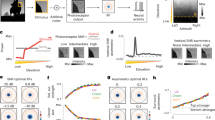Summary
The capacity of the compound eye to perceive its spatial environment is quantified by determining the number of different pictures that can be reconstructed by its array of retinula cells. We can then decide on the best compromise between an animal's capacity for fine detail and contrast sensitivity. The theory accounts for imperfect optics, photon noise, and angular motion limitations to acuity.
-
1.
There is an optimum parameterp = D Δ φ, whereD is the facet diameter andΔ φ is the interommatidial angle, for each mean luminance, angular velocity and mean object contrast. We find that this value ofp is approximately that found by Snyder (1977) for threshold resolution of a sinusoidal grating at the ommatidial sampling frequency.
-
2.
A diffraction limited eye (D Δ φ ≅λ/√¯3) is the optimum design only for those animals that are active in the brightest sunlight, and have a region of their eye that normally experiences low angular velocity, otherwise it is better to have a largerD Δ φ. λ is the wavelength of light in vacuum.
-
3.
The design of the flyMusca is consistent with that of an animal with high angular velocity.
Similar content being viewed by others
References
Barlow, H.B.: The size of ommatidia in apposition eyes. J. exp. Biol.29, 667–674 (1952)
Barlow, H.B.: The physical limits of visual discrimination. In: Photophysiology, Vol. 2 (Giese, A.C., ed.), pp. 163–202. New York: Academic Press 1964
Carlson, A.B.: Communication systems. New York: McGraw Hill 1975
Goetz, K.G.: Die optischen Übertragungseigenschaften der Komplexaugen vonDrosophila. Kybernetik2, 215–221 (1965)
Goldman, S.: Information theory. New York: Prentice Hall 1953
Goodman, J.W.: Introduction to Fourier optics. New York: McGraw Hill 1968
Horridge, G.A.: Looking at insect eyes. Sci. Amer., submitted (1976)
Kirschfeld, K.: The resolution of lens and compound eyes. In: Neural processing in visual systems (Zettler, F., Weiler, R., eds.). Berlin-Heidelberg-New York: Springer 1976
Kuiper, J.W., Leutscher-Hazelhoff, J.T.: Linear and nonlinear responses from the compound eye ofCalliphora erythrocephala. In: Cold Spr. Harb. Symp. quant. Biol.30, 419–428 (1965)
Land, M.F., Collett, T.S.: Chasing behaviour of houseflies (Fannia canicularis). J. comp. Physiol.89, 331–357 (1974)
Laughlin, S.B.: Receptor function in the apposition eye. An electrophysiological approach. In: Photoreceptor optics (Snyder, A.W., Menzel, R., eds.), pp. 479–498. Berlin-Heidelberg-New York: Springer 1975
Mallock, A.: Proc. roy. Soc. B55, 85 (1894)
Mallock, A.: Divided composite eyes. Nature (Lond.)110, 770–771 (1922)
Mazokhin-Porshnyakov, G.A.: Insect vision. New York: Plenum Press 1969
O'Neill, E.L.: Introduction to statistical optics. Reading Massachusetts: Addison-Wesley 1963
Pierce, J.R.: Symbols, signals and noise. New York: Harper and Row 1961
Rose, A.: Vision, human and electronic. New York-London: Plenum Press 1973
Snyder, A.W.: Acuity of compound eyes: Physical limitations and design. J. comp. Physiol.116, 161–182 (1977a)
Snyder, A.W.: The physics of vision in compound eyes. In: Handbook of sensory physiology, Vol. VII/6A, Chap. 7 (Autrum, H., ed.). Berlin-Heidelberg-New York: Springer 1977b
Snyder, A.W., Laughlin, S.B., Stavenga, D.G.: Information capacity of eyes. Vision Res., in press (1977)
Stavenga, D.G.: Optical qualities of the fly eye. An approach from the side of geometrical, physical and waveguide optics. In: Photoreceptor optics (Snyder, A.W., Menzel, R., eds.), pp. 126–144. Berlin-Heidelberg-New York: Springer 1975
Wehner, R.: Pattern recognition. In: The compound eye and vision of insects (Horridge, G.A., ed.), pp. 75–113. Oxford: Clarendon Press 1975
Wyszecki, G., Stiles, W.S.: Color science. New York-London-Sydney: John Wiley & Sons, Inc. 1967
Author information
Authors and Affiliations
Rights and permissions
About this article
Cite this article
Snyder, A.W., Stavenga, D.G. & Laughlin, S.B. Spatial information capacity of compound eyes. J. Comp. Physiol. 116, 183–207 (1977). https://doi.org/10.1007/BF00605402
Received:
Issue Date:
DOI: https://doi.org/10.1007/BF00605402




